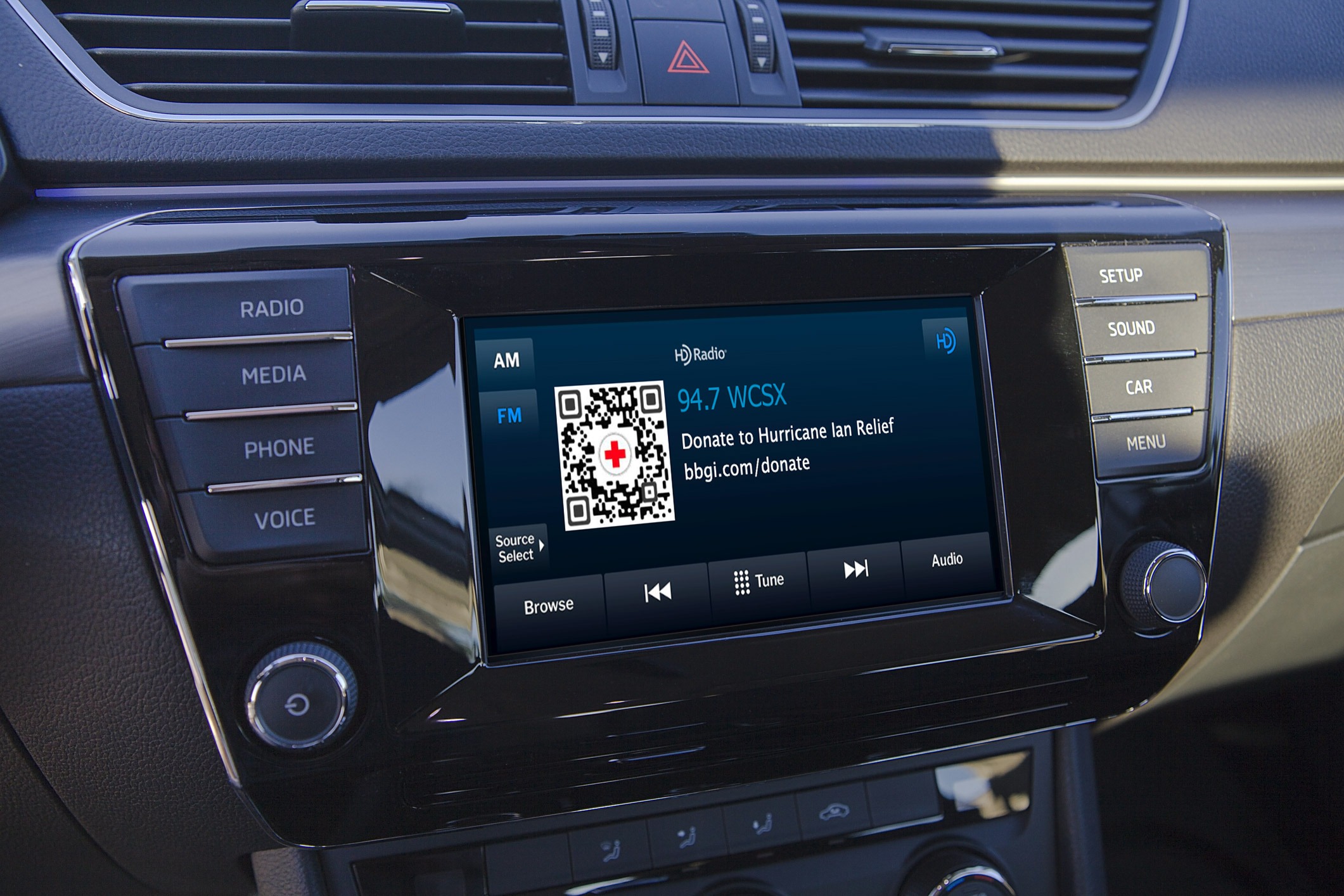
You programmers are either going to love me or curse me for today’s post. For everyone else in and out around the world of broadcast radio, I hope it’s an eye-opener about how radio’s relationship to the car in general, and the infotainment screen in particular is changing.
I’m an old school PD who programmed in the age of car radios with two knobs and six presets. No RDS. No album artwork. No digital.
The world of analog car radio didn’t have a whole lot of strategy behind. The key was to become one of the car owner’s six preset buttons, preferably the station in the #1 position. Beyond that, it was pretty much a matter of how well you programmed your station and its relative loudness as a driver punched around between stations.
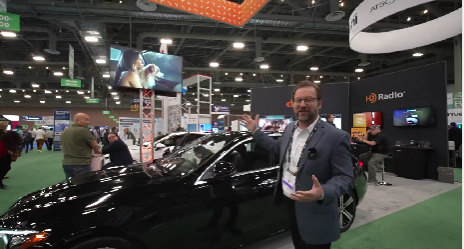
Today, programming in the car has become synonymous with military tactics. New technology, toys, and weaponry are available to the programmer – IF (big “if”) she decides to use them. I got to sit in on a presentation by Xperi mastermind Joe D’Angelo (pictured) yesterday. His new deck is loaded with new features and tools for stations, ranging from actual usage data with heat maps (think ratings), song lyrics on the screen (even synced to the song so you can karaoke on your way to work, school, or the Taylor Swift concert. And down the road (sorry), some of the technology we’ve seen at CES – the car reading your mood and adjusting the music to match it – is around the corner.

So we shouldn’t be surprised that dashboard messaging is becoming more sophisticated, now that more and more clever, tactical PDs have had a a chance to use it over the past few years. Paul and I got our education in this space thanks to Steve Newberry (pictured) now CEO of Quu, the company that has brought this technology to the radio industry. In his former life at the NAB, Steve hired us to run audits of dashboard displays in three markets back in 2017 – Grand Rapids, Philly, and Charlotte.
The results were revealing in that so many stations’ metadata displays were inaccurate, inert, or just plain lame. In a world where broadcast radio shares dashboard “real estate” with streaming audio platforms, satellite radio, podcasts, and even video, the way AM/FM stations look in the car becomes yet another indicator of our industry’s relevance in the fast-changing world of audio. The data was published for all to see (including non-NAB members), and has been updated by the NAB team. You can get it here.
And yet, a half dozen years later, I regularly speak with programmers in commercial, public, and Christian radio who have no earthly idea this technology is even possible. They somehow don’t notice it when in a car and/or they believe they have no control over the metadata and the messaging it can deliver. While it might be wise for the NAB to commission a follow-up audit, my subjective evaluation is that radio broadcasters as a whole have made significant progress in recent years. In general, stations look better on dashboard touchscreens, metadata messages have improved (and are even shorter), and album artwork has been upgraded.
On the sales front, many reps have connected agencies and retailers to this technology, allowing for advertisers to include logo artwork and slug lines during spots breaks, but also during programming content. To my knowledge, no other audio platforms offer this service. Advantage: radio.
for advertisers to include logo artwork and slug lines during spots breaks, but also during programming content. To my knowledge, no other audio platforms offer this service. Advantage: radio.
And there’s no shortage of research that shows “brand lift” for advertisers that include their artwork and a sales line on vehicles capable of RDS and/or HD radio visuals.
So, how’s it going? While there is still a lot of digital detritus on dashboard screens, radio broadcasters have made great strides.
But in a reversal of typical radio fortunes, the programming department has lagged behind. When I first started learning about metadata and its capabilities, my PD brain started moving and shaking, envisioning the possibilities. We have even tested some of them in our recent Techsurveys among the nearly 80% of respondents who have at least RDS technology in the vehicles they drive. Here’s the current metadata feature hierarchy based on our 2023 data:
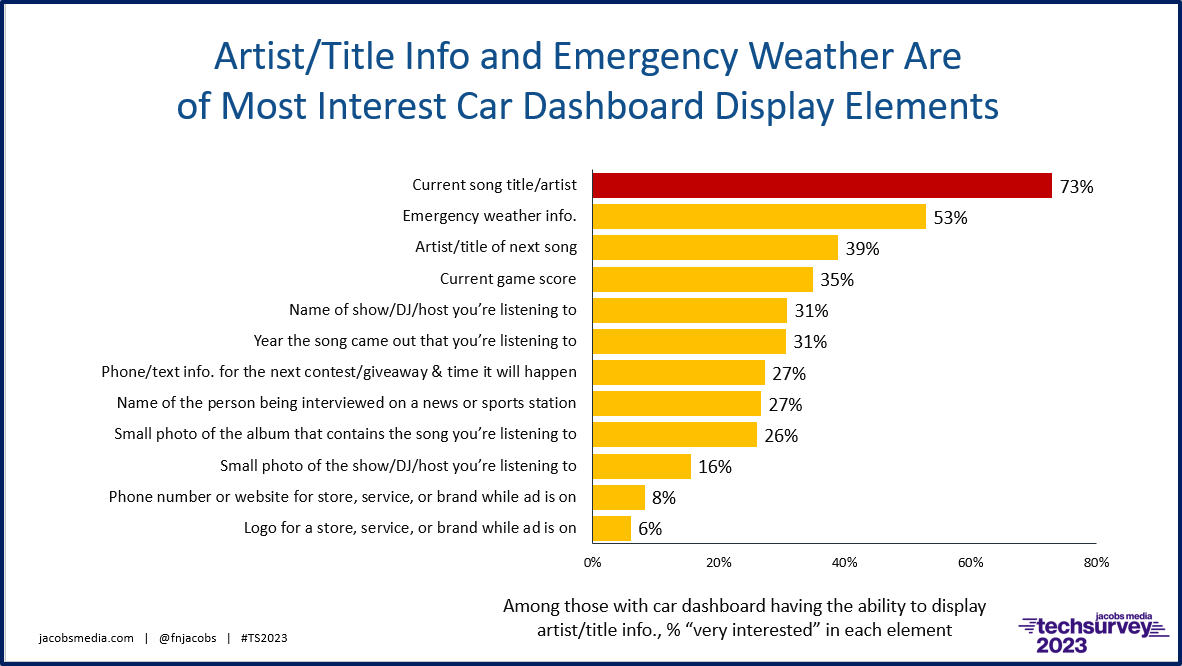
It’s pretty straightforward. Artist and title information of the song being played is table stakes. Nearly three in four consumers with the technology in their cars show the highest degree of interest in this now-basic feature. Emergency info is a solid second, while the artist and title of the next song, and the current score of a sports event you’re listening to are in the running, too.
I expect many of these metadata-driven features will increase in popularity as consumers get used to seeing them. It’s like going to a baseball game and seeing the speed of the pitch – a relatively new addition to scoreboard data. After you see it again and again, you being to start looking for it, you expect it to be part of the data set that is shown. Same thing with dashboard messaging for radio.

I spend most of my time in Detroit, so I’ve had an eye on what Beasley’s VP/National Content, Scott Jameson, (pictured) has been whipping up in this department for the company’s two leading rock stations in the market – the mighty, mighty WRIF and Classic Rock stalwart WCSX. Scott has approached the art of metadata programming both strategically and tactically with his messaging. Some of it is subtle, while other use cases have been highly intentional, hoping to spur a reaction or at least an impression from drivers and passengers.
Take the recent Aerosmith concert for example, their final appearance in Detroit:
“We wanted to try something different when giving away tickets. I built a 2-day vertical in prime time on Wednesday and Thursday, the last day and first day of a PPM week. On-air and online promos directed fans to ‘watch & win’ their vehicle display for when the next pair is given away, with the trigger being an Aerosmith track we play.

“Two hours before each giveaway, the information appeared on the dashboard display, revealing exactly when to listen and win. For added visual engagement we worked with legendary Detroit rock photographer Ken Settle using a suite of Aerosmith images he photographed over the years in the Motor City.”
Here’s an audio clip from the giveaway.
Scott also talked about why dashboard metadata is an untapped resource for programmers:
“We live in a screen centric world so when you combine the intimacy of the car environment, you’re adding another level of connectivity complementing the audio. We do a nice job monetizing client ad-syncs and sponsorships, so there’s no reason we can’t broaden the use for content and consumer engagement which can ultimately, over time build brand loyalty.”
And more listening. What about moment-to-moment listening using metadata as a trigger?
“This is the first time we used the vehicle dashboard as a TSL tactic. While stations typically display information that’s happening in the moment, the technology of Quu allows programmers to create anything they can dream up using text and images for both HD and analog radio displays. I would encourage PD’s and digital content creators to look at this as another content branding tool, along with an opportunity to bring new revenue ideas to the sales team.”
There are other benefits beyond expanding time-spent listening and occasions. For the 50th anniversary of Pink Floyd’s “Dark Side of the Moon” album earlier this year, Scott had his team create special artwork that played during the days they featured this iconic piece of Classic Rock.

The approach is more low-key than “watch & win,” but that suits this moment and celebration. Dashboard metadata doesn’t always have to be in your face. In fact, regular impressions drive recall.
I also love the capability to be “in the moment,” something radio used to do better. With some planning and a little creativity, dashboard metadata allows radio to meet those occasions head-on with relevant messaging:
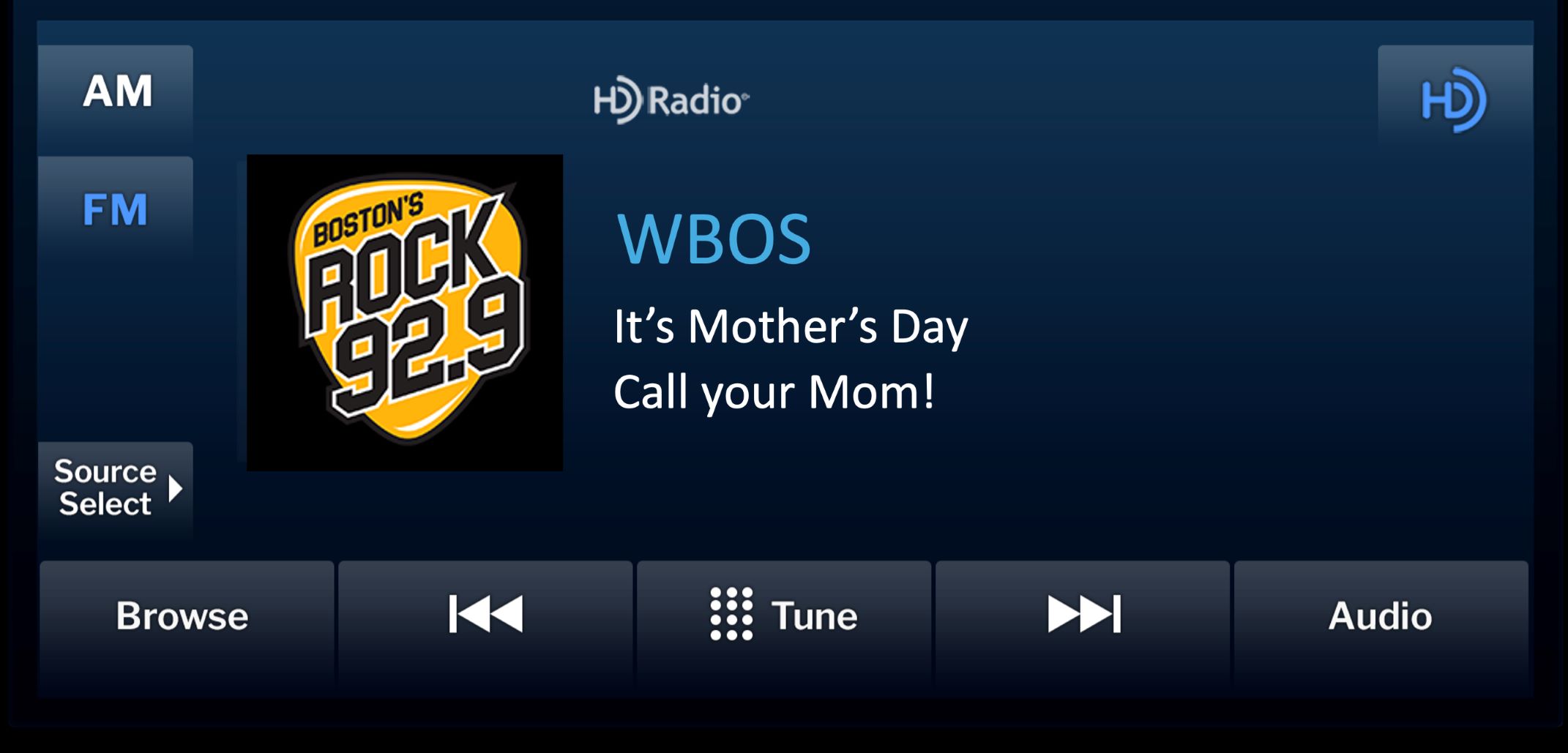
There’s also those moments when messaging can save lives – or repair them. The Beasley stations have been especially active across their portfolio of stations during the many disasters we’ve witnessed over the past few years. A “text-to-donate” message and/or a QR code gets the job done. (See the photo on the top of this post.)
Scott mentioned a new Michigan law that was signed this summer by Governor Gretchen Whitmer. It is now illegal to hold or use a cellphone while driving in the state. Drivers can get pulled over and ticketed if they are caught holding or using a cellphone for any reason, whether it’s to make a call, send a text, scroll social media, etc.
For this type of legislation, which is likely to spread to more states, dashboard metadata becomes a legal way to disseminate messages.
Scott, Paul, and I have collaborated with Steve Newberry and his team on smart uses of this messaging for a couple years now. I like to think of it as the equivalent of push messages on your dashboard. Instead of the “Check engine light” coming on (which we always notice), metadata on our car infotainment screens gets noticed. Clearly, this is a new programming and marketing tool for radio content creators. It’s exciting to think about how this technology will be used moving forward.
It is also about improving the visual interface of today’s vehicle displays, which are only getting bigger, more beautiful, and more attention-getting. As Scott notes, it’s all about using the metadata “to engage, inform and entertain.”
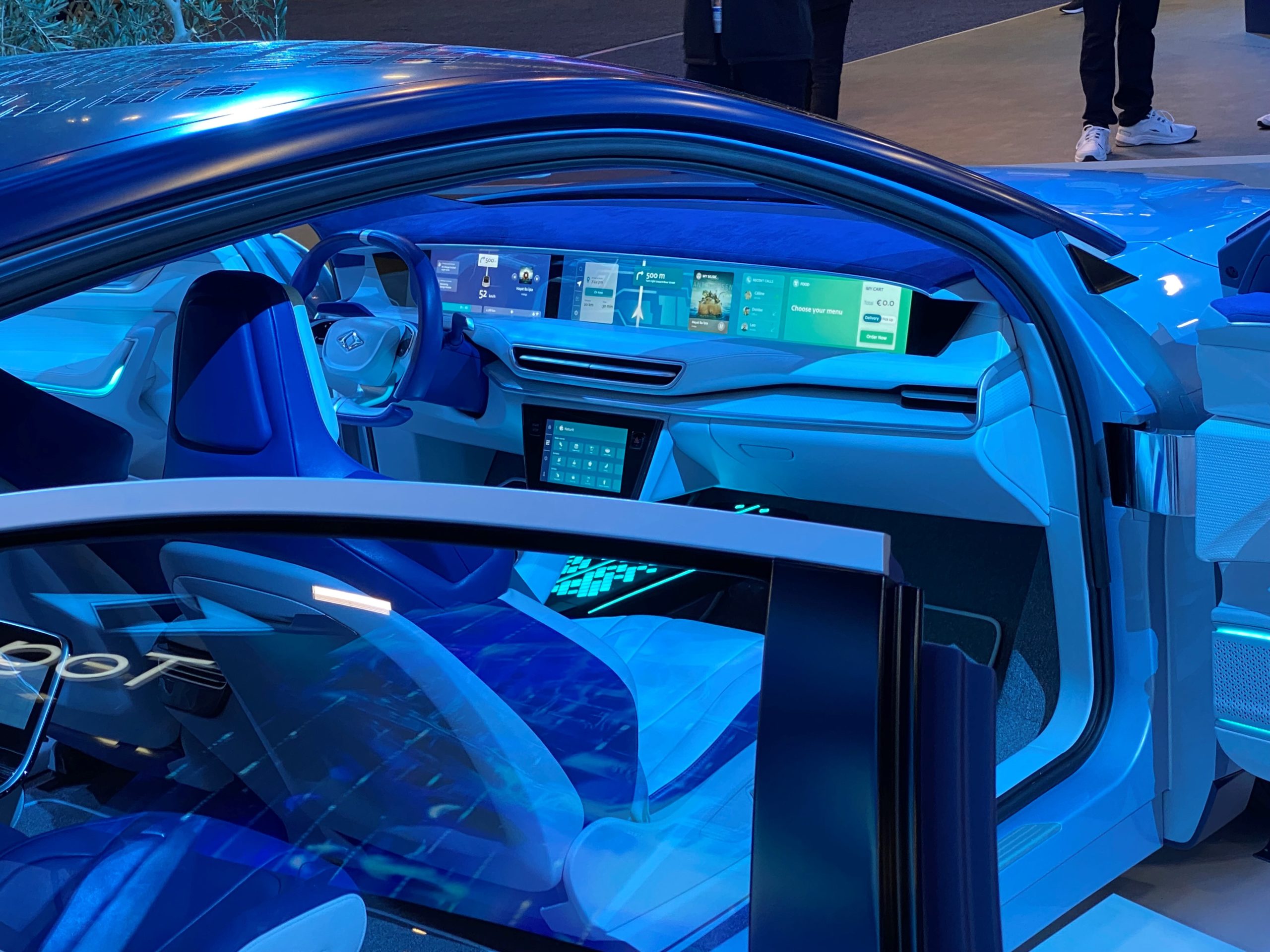
Radio has come a long way since our DASH Conferences that began exactly one decade ago. With dashboard metadata in the tool kit, radio’s best days in the car may still be ahead.
Full disclosure: Both Xperi and Quu are clients. We love working for both, and believe they are contributing in huge ways to radio’s future in the dashboard. Here are their links:
- Media And Technology In 2025: Believe It Or Not! - April 18, 2025
- In Radio, You Just Never Know - April 17, 2025
- The Secret To Making A Great Podcast (And Great Radio) - April 16, 2025




You mention the recent Michigan legislation that prohibits handheld phones as driver distractions. Not to be a wet blanket, Fred, but shouldn’t we be a little uncomfortable promoting ways to circumvent a public safety statute?
Hmmm….I didn’t see it this way, but I see your point. The dashboard is part of the car, containing myriad messages drivers become used to. I view metadata that way. A mobile phone is an external gadget we hold in our hands. To me, that’s the difference.
I have to say I don’t care for this at all. There is enough of a problem with “distracted driving” as it is now.
Jerry, I hear you. See my comments to Dave Mason.
First thing that comes to mind is the “distracted driving” part. But most everyone has distractions in the car. Signs, billboards, license plates -and yes-The Dashboard”. The Pink Floyd/Logo merge is classic. My 2018 Corolla will show title/artist while driving. HD stations show album art when stopped. One station tried to sell the RDS messages and they turned out to be a horrendous disaster. Having a “billboard” on the dashboard is a great idea. Having complicated graphics isn’t. Radio can be clever and make even the stuffiest driver smile. Promotions genius Paige Nienaber would encourage us to “Google-ize” our websites as Google does during certain special days. The challenge for radio is to “Google-ize” the dashboard. Drivers eyes will wander at a traffic light or in one of SoCal’s traffic slowdowns. Having something visual to go along with the audio -priceless.
By the way–that new Michigan law? A similar law has been effect in California since Arnold was gov’ner. It’s not enforced, and probably won’t be in most cases. Police seem to have much larger fish to fry these days. The law in California is toothless.
Thanks for these important “second thoughts,” Dave. As you know, when AM radio was first installed in dashboards nearly a century ago, a movement formed to ban them on the grounds they were a driving distraction. And the best goes on.